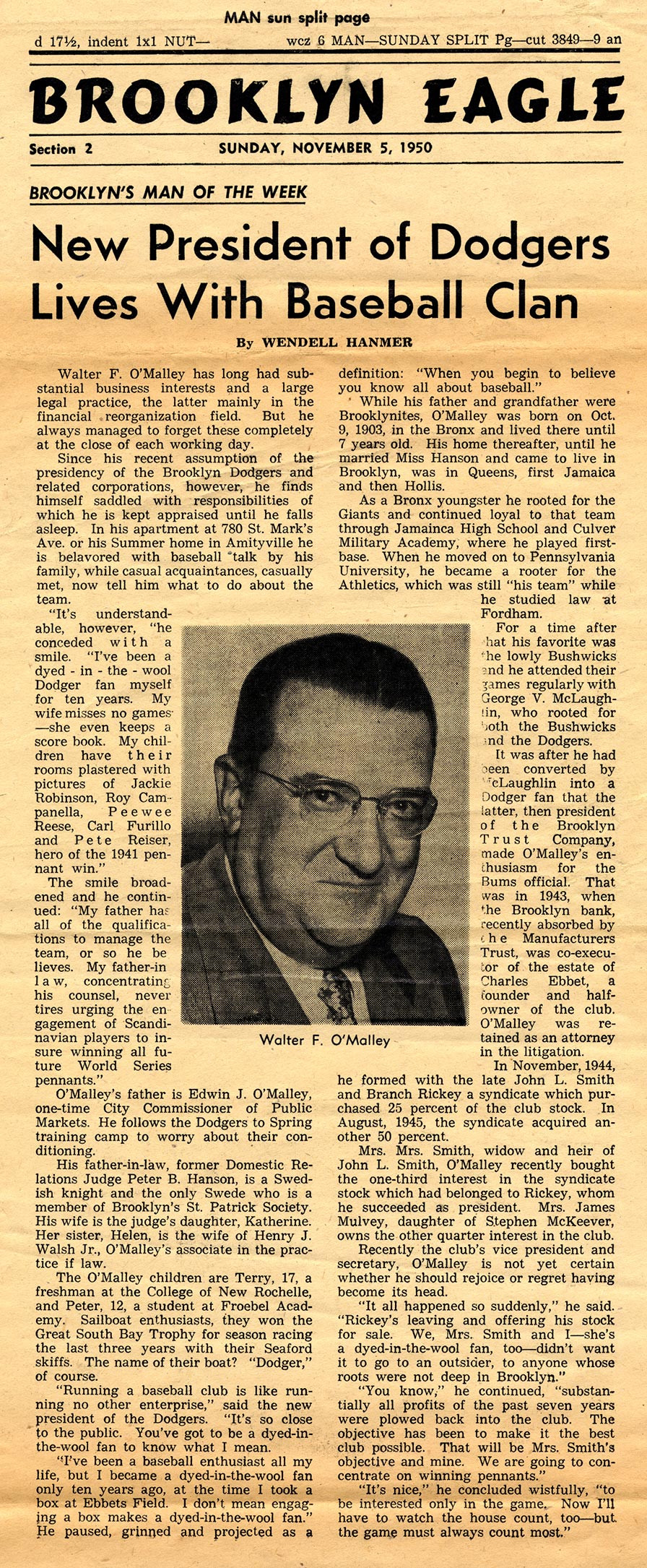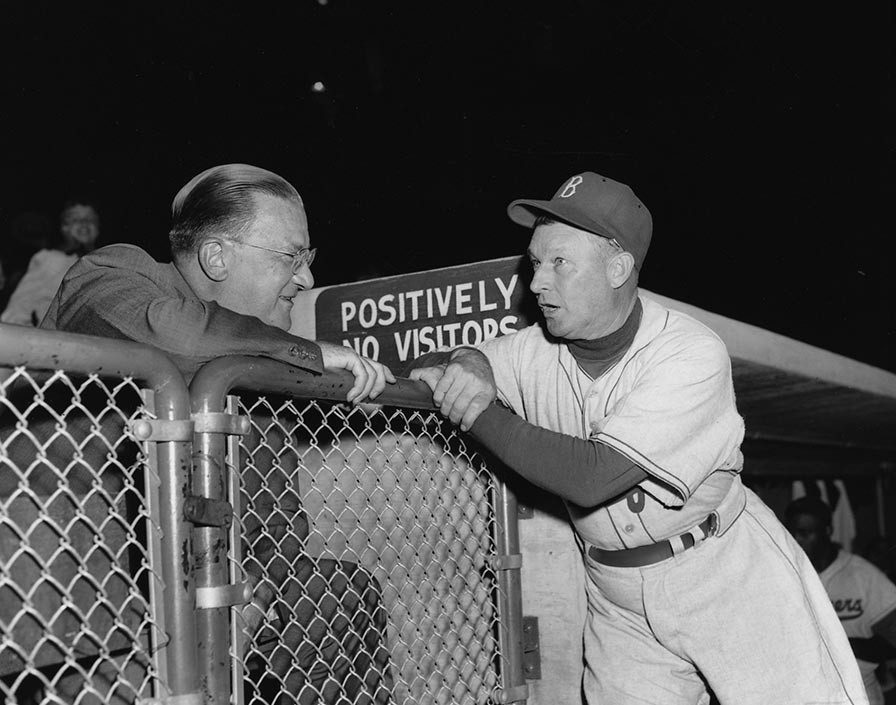This Day in Walter O’Malley History:
-
The Brooklyn Eagle introduces new Dodger President Walter O’Malley to its readers in a lengthy commentary about his background. “Walter F. O’Malley has long had substantial business interests and a large legal practice, the latter mainly in the financial reorganization field...“I’ve been a dyed-in-the-wool Dodger fan myself for ten years. My wife misses no games — she even keeps a score book. My children have their rooms plastered with pictures of Jackie Robinson, Roy Campanella, Pee Wee Reese, Carl Furillo and Pete Reiser, hero of the 1941 pennant win.”...“O’Malley’s father is Edwin J. O’Malley, one-time City Commissioner of Public Markets. He follows the Dodgers to Spring training camp to worry about their conditioning. His father-in-law, former Domestic Relations Judge Peter B. Hanson, is a Swedish knight and the only Swede who is a member of Brooklyn’s St. Patrick Society. His wife is the judge’s daughter, Katherine. Her sister, Helen, is the wife of Henry J. Walsh Jr., O’Malley’s associate in the practice of law. The O’Malley children are Terry, 17, a freshman at the College of New Rochelle, and Peter, 12, a student at Froebel Academy. Sailboat enthusiasts, they won the Great South Bay Trophy for season racing the last three years with their Seaford skiff. The name of their boat? ‘Dodger,’ of course...As a Bronx youngster he rooted for the Giants and continued loyal to that team through Jamaica High School and Culver Military Academy, where he played first base. When he moved on to Pennsylvania University, he became a rooter for the Athletics, which was still ‘his team’ while he studied law at Fordham.” Wendell Hanmer, Brooklyn Eagle, November 5, 1950
-
Walter O’Malley announces that Chuck Dressen will return as manager of the Dodgers for the 1952 season on a one-year contract. “I cannot find evidence that any of the players would be happier without Dressen,” said O’Malley. “Some admitted freely that they were disappointed in themselves, but I am convinced that the team as a whole did not lay down at any time. The boys merely pressed too hard.” O’Malley explained that in hindsight, after the firing of Burt Shotton, following the disappointing 1950 loss to the Phillies on the last day of the season, he learned from his decisions. “Perhaps I acted too hastily. As I look back at 1950, I know I made mistakes. I know now that I can’t be taking it out on the manager every time we lose a pennant on the last day. I now have a better insight on the situation. Possibly, in Shotton’s case, with a year’s experience I would have not been so precipitous. Burt is a fine man, a good baseball man. So is Chuck, who will be even a better manager next year, getting more mileage out of his material; conserving something for the stretch run.” Louis Effrat, New York Times, November 6, 1951
-
Walter O’Malley speaks with Miami Herald writer Jimmy Burns on improving attendance among Major League Baseball clubs. “There isn’t anything wrong with attendance that could not be cured by hard work on the part of club owners,” said O’Malley. Jimmy Burns, The Sporting News, November 5, 1952 O’Malley told Burns attendance can be improved by using regular players longer in exhibition games; requiring clubs to use their best efforts in every game (even when they are out of the race); realignment of the minor leagues to follow population growth; and increased interest in the organizations that support youth baseball such as Little League and the American Legion.
-
Roscoe McGowen writes in The Sporting News of Walter O’Malley’s concern for the wet weather in Vero Beach, Florida, which was the reason O’Malley took an unscheduled vacation for one week. Dodger Vice President Fresco Thompson explains O’Malley was not really on vacation, but was concerned about the condition of his new stadium, which was set to open in March, at Dodgertown. Steady rain for 10 days there had put in jeopardy a large portion of earth to serve as support for the end of the grandstand whereby fans would ascend a moderate concrete walkway to their seats. Roscoe McGowen, The Sporting News, November 5, 1952
-
Walter O’Malley flies to Vero Beach, Florida to inspect Dodgertown’s facilities for a Baseball School to be conducted February 13-22, 1954 for managers, coaches and umpires of amateur teams. High school and college coaches are expected to attend, while officials of American Legion, Little League, Police Athletic League, Catholic Youth Organization and sandlot were also invited. Dodgers Pee Wee Reese and Carl Erskine head the list of instructors, along with major league umpire Larry Goetz.
-
Melvin Durslag writes in the Los Angeles Herald-Examiner about the chances of using Dodger Stadium for a possible American Football League team. “To start with, said Walter O’Malley, he would not be interested in negotiating with someone looking for a bargain. ‘We haven’t been approached,’ he says, ‘but if we should be, I would want a tenant to remember that we pay $800,000 a year in property taxes and we also pay corporate taxes and state taxes.’” O’Malley was asked by Durslag if he would be interested in joining a football ownership group in Los Angeles. “I wouldn’t buy a nickel’s worth,” he replied. “I believe in football being operated by football pros and baseball by baseball pros. I want no part of something I don’t understand.” According to Durslag, “O’Malley last attended a football game eight years ago in the Rose Bowl. Otherwise, he hasn’t yet recovered from a traumatic experience of the late 1940’s when Branch Rickey, then his partner in Brooklyn, talked him into bankrolling the football Brooklyn Dodgers, a member of the All-America Conference. In one year, encamped in Ebbets Field, the club lost $750,000. Abandoning the team and joining with Dan Topping in the operation of the football New York Yankees at Yankee Stadium, Rickey and O’Malley, the touchdown twins, blew some more money.” Melvin Durslag, Los Angeles Herald-Examiner, November 5, 1965



